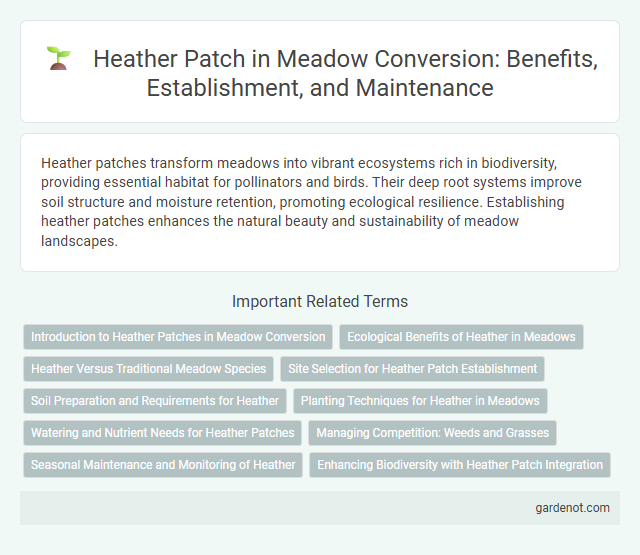Heather patches transform meadows into vibrant ecosystems rich in biodiversity, providing essential habitat for pollinators and birds. Their deep root systems improve soil structure and moisture retention, promoting ecological resilience. Establishing heather patches enhances the natural beauty and sustainability of meadow landscapes.
Introduction to Heather Patches in Meadow Conversion
Heather patches are vital components in meadow conversion, contributing to biodiversity by supporting various pollinators and wildlife. These dense, shrubby areas improve soil health through nitrogen fixation and provide natural habitat corridors. Integrating heather patches enhances ecosystem resilience and promotes sustainable land management practices.
Ecological Benefits of Heather in Meadows
Heather patches in meadows enhance biodiversity by providing essential habitats and nectar sources for pollinators like bees and butterflies, supporting ecosystem health. Their deep root systems improve soil stability and nutrient cycling, promoting resilience against erosion and drought in meadow environments. These ecological benefits contribute significantly to meadow conversion projects aimed at restoring natural landscapes and sustaining wildlife populations.
Heather Versus Traditional Meadow Species
Heather patches exhibit higher biodiversity compared to traditional meadow species, supporting specialized pollinators such as bumblebees and certain butterfly species. Unlike traditional meadows dominated by grasses and wildflowers like oxeye daisy or black knapweed, heather (Calluna vulgaris) thrives in acidic, nutrient-poor soils, contributing to unique heathland ecosystems. The structural complexity of heather enhances habitat diversity, promoting native fauna and improving ecosystem resilience during meadow conversion projects.
Site Selection for Heather Patch Establishment
Optimal site selection for heather patch establishment requires well-drained, acidic soils with a pH between 4.5 and 5.5, commonly found in heathlands or sandy, nutrient-poor areas. Adequate sunlight exposure and minimal shading ensure robust growth and flowering of heather species such as Calluna vulgaris. Avoiding waterlogged or highly fertile soils prevents competition from grasses and broadleaf plants, promoting successful meadow conversion.
Soil Preparation and Requirements for Heather
Heather thrives in acidic, well-drained soils with a pH between 4.5 and 5.5, requiring sandy or peaty substrates rich in organic matter for optimal growth. Proper soil preparation involves removing alkaline topsoil, incorporating ericaceous compost, and ensuring adequate drainage to prevent root rot. Maintaining consistent moisture without waterlogging supports healthy root development and successful establishment of heather patches in meadow conversions.
Planting Techniques for Heather in Meadows
Planting heather in meadows requires careful soil preparation, ensuring well-drained, acidic conditions with a pH between 4.5 and 5.5 to promote healthy root development. Use young heather plugs spaced 30-45 cm apart to allow adequate airflow and reduce competition for nutrients. Applying a mulch layer of pine needles or bark chips helps retain moisture and suppress weeds, enhancing the establishment of vibrant heather patches.
Watering and Nutrient Needs for Heather Patches
Heather patches require well-drained, acidic soil with a pH between 4.5 and 6.0 to thrive, making consistent watering essential to maintain moist, but not waterlogged, conditions. Use rainwater or soft water to avoid alkaline buildup, and apply a balanced, slow-release fertilizer formulated for acid-loving plants during early spring to support healthy growth. Proper watering and nutrient management enhance flowering and sustain vibrant foliage in meadow conversions featuring heather patches.
Managing Competition: Weeds and Grasses
Heather patches require careful management to minimize competition from invasive weeds and aggressive grasses that can hinder their growth. Implementing targeted weed control methods, such as selective herbicide application or manual removal, ensures that heather plants receive adequate nutrients, sunlight, and space to thrive. Regular monitoring of the patch helps maintain a balanced ecosystem, promoting biodiversity and sustaining the meadow conversion's ecological benefits.
Seasonal Maintenance and Monitoring of Heather
Seasonal maintenance of heather patches involves regular inspection and removal of dead or diseased foliage to promote healthy growth and prevent pest infestations. Monitoring soil moisture levels and adjusting irrigation schedules ensure optimal hydration without waterlogging, which is crucial during dry summer months. Conducting periodic nutrient assessments and applying balanced fertilizers supports vibrant blooming and resilience throughout changing seasons.
Enhancing Biodiversity with Heather Patch Integration
Heather patch integration significantly enhances biodiversity by providing critical habitat and food sources for pollinators such as bees and butterflies. This native plant supports a variety of bird species and small mammals, contributing to a balanced ecosystem within meadow conversions. The dense, nitrogen-poor soil tolerance of heather patches promotes diverse plant communities, improving overall meadow health and resilience.
Heather patch Infographic

 gardenot.com
gardenot.com